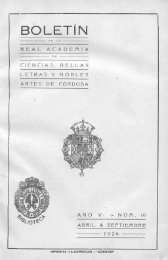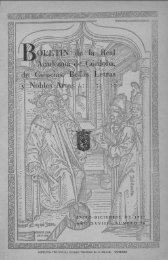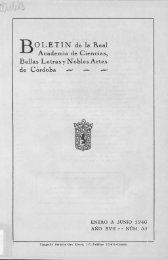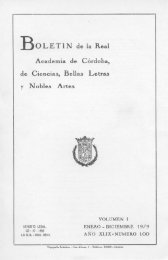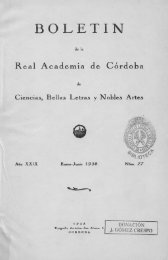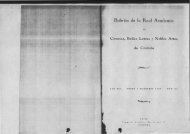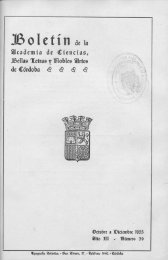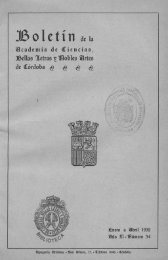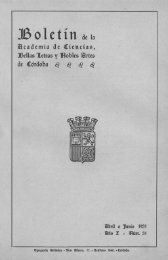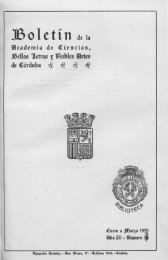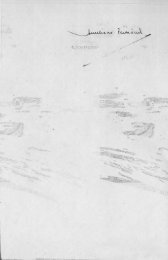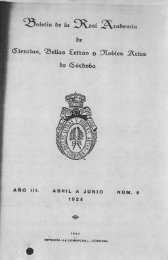- Page 1: BO LETIN de la Real Academia de Có
- Page 6 and 7: BOLETÍN DE LA REAL ACADEMIA DE CÓ
- Page 8 and 9: 4 GALERÍA DE ACADÉMICOS Tiene una
- Page 11 and 12: JUAN RAMÓN JIMÉNEZ. LA EXPRESIÓN
- Page 13 and 14: JUAN RAMÓN JIMÉNEZ. LA EXPRESIÓN
- Page 15 and 16: JUAN RAMÓN JIMÉNEZ. LA EXPRESIÓN
- Page 17 and 18: JUAN RAMÓN JIMÉNEZ. LA EXPRESIÓN
- Page 19 and 20: JUAN RAMÓN JIMÉNEZ. LA EXPRESIÓN
- Page 21: JUAN RAMÓN JIMÉNEZ. LA EXPRESIÓN
- Page 25 and 26: JUAN RAMÓN JIMÉNEZ. LA EXPRESIÓN
- Page 27 and 28: JUAN RAMÓN JIMÉNEZ. LA EXPRESIÓN
- Page 29: JUAN RAMÓN JIMÉNEZ. LA EXPRESIÓN
- Page 33 and 34: PRESENTACIÓN Y JUSTIFICACIÓN DEL
- Page 35 and 36: PRESENTACIÓN Y JUSTIFICACIÓN DEL
- Page 37 and 38: PRESENTACIÓN Y JUSTIFICACIÓN DEL
- Page 39: PRESENTACIÓN Y JUSTIFICACIÓN DEL
- Page 42 and 43: 38 ÁNGEL AROCA LARA fructificado s
- Page 45: Celebración del día de Góngora 1
- Page 48 and 49: 44 ÁNGEL AROCA LARA El primer paso
- Page 51 and 52: GÓNGORA: POESIÁ Y ESPÍRITU: PAR
- Page 53 and 54: GONGORA: POESÍA Y ESPÍRITU: PARÉ
- Page 55 and 56: GÓNGORAi POESÍA Y ESPÍRITU: PAR
- Page 57: PRESENTACIÓN DEL ACTO LITERARIO Jo
- Page 60 and 61: 56 ANTONIO CRUZ CASADO informa, en
- Page 62 and 63: 58 ANTONIO CRUZ CASADO Otras opinio
- Page 64 and 65: 60 ANTONIO CRUZ CASADO los cuales,
- Page 66 and 67: 62 ANTONIO CRUZ CASADO Un recurso p
- Page 68 and 69: 64 ANTONIO CRUZ CASADO Quizás pued
- Page 71 and 72: AERINITA. RARA Y CONTROVERTIDA ESPE
- Page 73:
AERINITA. RARA Y CONTROVERTIDA ESPE
- Page 76 and 77:
72 ANTONIO ARJONA CASTRO cual escri
- Page 78 and 79:
74 ANTONIO ARJONA CASTRO vientre an
- Page 80 and 81:
76 ANTONIO ARJONA CASTRO "Entonces
- Page 82 and 83:
78 ANTONIO ARJONA CASTRO hormigas c
- Page 84 and 85:
80 ÁNGEL AROCA LARA Todos y cada u
- Page 86 and 87:
82 Gion- o: El sueño de San Joaqu
- Page 89 and 90:
TURQUÍA. VIAJE AL PAÍS LAICO DEL
- Page 91 and 92:
TURQUÍA. VIAJE AL PAÍS LAICO DEL
- Page 93 and 94:
TURQUÍA. VIAJE AL PAÍS LAICO DEL
- Page 95 and 96:
TURQUÍA. VIAJE AL PAÍS LAICO DEL
- Page 97:
TURQUÍA. VIAJE AL PAÍS LAICO DEL
- Page 100 and 101:
96 MARIANO AGUAYO ÁLVAREZ sobre lo
- Page 102 and 103:
98 MARIANO AGUAYO ÁLVAREZ empapars
- Page 105 and 106:
«LA TRUHANA», UN HITO HACIA LA CA
- Page 107 and 108:
«LA TRUHANA», UN HITO HACIA LA CA
- Page 109 and 110:
ESTRUCTURA ESCENA I ESCENA II ESCEN
- Page 111 and 112:
«LA TRUHANA», UN HITO HACIA LA CA
- Page 113 and 114:
«LA TRUHANA», UN HITO HACIA LA CA
- Page 115 and 116:
«LA TRUHANA», UN HITO HACIA LA CA
- Page 117 and 118:
«LA TRUHANA», UN HITO HACIA LA CA
- Page 119:
«LA TRUHANA», UN HITO HACIA LA CA
- Page 122 and 123:
118 JUAN RAFAEL VÁZQUEZ LESMES mar
- Page 124 and 125:
120 JUAN RAFAEL VÁZQUEZ LESMES das
- Page 126 and 127:
122 JUAN RAFAEL VÁZQUEZ LESMES cue
- Page 128 and 129:
124 JUAN RAFAEL VÁZQUEZ LESMES 1.2
- Page 130 and 131:
126 JUAN RAFAEL VÁZQUEZ LESMES int
- Page 132 and 133:
128 JUAN RAFAEL VÁZQUEZ LESMES dud
- Page 134 and 135:
130 JUAN RAFAEL VÁZQUEZ LESMES pro
- Page 136 and 137:
132 JUAN RAFAEL VÁZQUEZ LESMES anu
- Page 138 and 139:
134 JUAN RAFAEL VÁZQUEZ LESMES Sob
- Page 140 and 141:
136 JUAN RAFAEL VÁZQUEZ LESMES No
- Page 142 and 143:
138 JUAN RAFAEL VÁZQUEZ LESMES Dem
- Page 144 and 145:
140 JUAN RAFAEL VÁZQUEZ LESMES del
- Page 146 and 147:
142 ANTONIO MANZANO SOLANO PRAGMATI
- Page 148 and 149:
144 ANTONIO MANZANO SOLANO ciudadan
- Page 150 and 151:
146 ANTONIO MANZANO SOLANO limitada
- Page 152 and 153:
148 ANTONIO MANZANO SOLANO se desar
- Page 154 and 155:
150 ANTONIO MANZANO SOLANO luntad r
- Page 156 and 157:
152 ANTONIO MANZANO SOLANO apoyado
- Page 158 and 159:
154 ANTONIO MANZANO SOLANO El certi
- Page 160 and 161:
156 ANTONIO MANZANO SOLANO con la a
- Page 162 and 163:
158 ANTONIO MANZANO SOLANO J0027- Z
- Page 164 and 165:
160 ANTONIO MANZANO SOLANO Número
- Page 166 and 167:
162 ANTONIO MANZANO SOLANO Este Arc
- Page 168 and 169:
164 ANTONIO MANZANO SOLANO SARMIENT
- Page 170 and 171:
166 SEGUNDO GUTIÉRREZ DOMÍNGUEZ
- Page 172 and 173:
168 SEGUNDO GUTIÉRREZ DOMÍNGUEZ
- Page 174 and 175:
170 SEGUNDO GUTIÉRREZ DOMÍNGUEZ s
- Page 176 and 177:
172 SEGUNDO GUTIÉRREZ DOMÍNGUEZ
- Page 178 and 179:
174 SEGUNDO GUTIÉRREZ DOMÍNGUEZ "
- Page 180 and 181:
176 SEGUNDO GUTIÉRREZ DOMÍNGUEZ
- Page 182 and 183:
178 SEGUNDO GUTIÉRREZ DOMÍNGUEZ m
- Page 184 and 185:
180 SEGUNDO GUTIÉRREZ DOMÍNGUEZ E
- Page 186 and 187:
182 JUAN RAFAEL VÁZQUEZ LESMES tie
- Page 188 and 189:
184 JUAN RAFAEL VÁZQUEZ LESMES su
- Page 190 and 191:
186 JUAN RAFAEL VÁZQUEZ LESMES alb
- Page 192 and 193:
188 JUAN RAFAEL VÁZQUEZ LESMES nic
- Page 194 and 195:
190 JUAN RAFAEL VÁZQUEZ LESMES Un
- Page 196 and 197:
192 JUAN RAFAEL VÁZQUEZ LESMES Dio
- Page 198 and 199:
194 RODRIGO POZO LORA medidas sufic
- Page 200 and 201:
196 RODRIGO POZO LORA La concentrac
- Page 202 and 203:
198 RODRIGO POZO LORA do en la actu
- Page 204 and 205:
200 RODRIGO POZO LORA Evolución de
- Page 206 and 207:
Tabla 3.1.— EVOLUCIÓN DE LAS CON
- Page 208 and 209:
Tabla 3.3.— EVOLUCIÓN DE LAS CON
- Page 210 and 211:
206 RODRIGO POZO LORA Tabla 4.— E
- Page 212 and 213:
Tabla 5.2.— EVOLUCIÓN DE LA FREC
- Page 214 and 215:
An Tabla 5.4.— EVOLUCIÓN DE LA F
- Page 217 and 218:
INTELIGENCIA ARTIFICIAL Y ESTADÍST
- Page 219 and 220:
INTELIGENCIA ARTIFICIAL Y ESTADÍST
- Page 221:
INTELIGENCIA ARTIFICIAL Y ESTADÍST
- Page 224 and 225:
220 ESTEBAN MÁRQUEZ TRIGUERO ubica
- Page 226 and 227:
222 ESTEBAN MÁRQUEZ TRIGUERO Descr
- Page 228 and 229:
224 ESTEBAN MÁRQUEZ TRIGUERO 400 m
- Page 230 and 231:
226 ESTEBAN MÁRQUEZ TRIGUERO 64. J
- Page 232 and 233:
228 ESTEBAN MÁRQUEZ TRIGUERO I12 M
- Page 234 and 235:
230 ESTEBAN MÁRQUEZ TRIGUERO Fot.
- Page 236 and 237:
232 ESTEBAN MÁRQUEZ TRIGUERO Fot.
- Page 238 and 239:
234 ESTEBAN MÁRQUEZ TRIGUERO Bibli
- Page 240 and 241:
236 FRANCISCO CRESPÍN CUESTA fecha
- Page 242 and 243:
238 FRANCISCO CRESPÍN CUESTA Abdal
- Page 244 and 245:
240 FRANCISCO CRESPÍN CUESTA proch
- Page 246 and 247:
242 FRANCISCO CRESPÍN CUESTA a los
- Page 248 and 249:
244 FRANCISCO CRESPÍN CUESTA trato
- Page 250 and 251:
246 FRANCISCO CRESPÍN CUESTA quien
- Page 253 and 254:
INSTITUTO DE ACADEMIAS DE ANDALUCI
- Page 255 and 256:
INSTITUTO DE ACADEMIAS DE ANDALUCÍ
- Page 257 and 258:
INSTITUTO DE ACADEMIAS DE ANDALUCÍ
- Page 259 and 260:
INSTITUTO DE ACADEMIAS DE ANDALUCÍ
- Page 261 and 262:
INSTITUTO DE ACADEMIAS DE ANDALUCÍ
- Page 263 and 264:
INSTITUTO DE ACADEMIAS DE ANDALUCÍ
- Page 265 and 266:
INSTITUTO DE ACADEMIAS DE ANDALUCÍ
- Page 267 and 268:
INSTITUTO DE ACADEMIAS DE ANDALUCÍ
- Page 269 and 270:
INSTITUTO DE ACADEMIAS DE ANDALUCÍ
- Page 271 and 272:
INSTITUTO DE ACADEMIAS DE ANDALUCÍ
- Page 273 and 274:
INSTITUTO DE ACADEMIAS DE ANDALUCÍ
- Page 275 and 276:
INSTITUTO DE ACADEMIAS DE ANDALUCÍ
- Page 277 and 278:
INSTITUTO DE ACADEMIAS DE ANDALUCÍ
- Page 279 and 280:
INSTITUTO DE ACADEMIAS DE ANDALUCÍ
- Page 281 and 282:
INSTITUTO DE ACADEMIAS DE ANDALUCÍ
- Page 283 and 284:
INSTITUTO DE ACADEMIAS DE ANDALUCÍ
- Page 285 and 286:
INSTITUTO DE ACADEMIAS DE ANDALUCÍ
- Page 287 and 288:
INSTITUTO DE ACADEMIAS DE ANDALUCÍ
- Page 289 and 290:
INSTITUTO DE ACADEMIAS DE ANDALUCÍ
- Page 291 and 292:
INSTITUTO DE ACADEMIAS DE ANDALUCÍ
- Page 293 and 294:
INSTITUTO DE ACADEMIAS DE ANDALUCÍ
- Page 295 and 296:
INSTITUTO DE ACADEMIAS DE ANDALUCÍ
- Page 297 and 298:
INSTITUTO DE ACADEMIAS DE ANDALUCÍ
- Page 299 and 300:
INSTITUTO DE ACADEMIAS DE ANDALUCÍ
- Page 301 and 302:
INSTITUTO DE ACADEMIAS DE ANDALUCÍ
- Page 303 and 304:
INSTITUTO DE ACADEMIAS DE ANDALUCÍ
- Page 305 and 306:
INSTITUTO DE ACADEMIAS DE ANDALUCÍ
- Page 307 and 308:
INSTITUTO DE ACADEMIAS DE ANDALUCÍ
- Page 309 and 310:
INSTITUTO DE ACADEMIAS DE ANDALUCÍ
- Page 311 and 312:
INSTITUTO DE ACADEMIAS DE ANDALUCÍ
- Page 313 and 314:
INSTITUTO DE ACADEMIAS DE ANDALUCÍ
- Page 315:
En el recuerdo
- Page 318 and 319:
314 ÁNGEL AROCA LARA No sé cómo
- Page 320 and 321:
316 ÁNGEL AROCA LARA pundonor con
- Page 322 and 323:
318 JUAN LUIS GONZÁLEZ-RIPOLL JIM
- Page 325 and 326:
INFORME SOBRE EL LEGADO "BLANCO CAR
- Page 327:
INFORME SOBRE EL LEGADO "BLANCO CAR
- Page 331 and 332:
RESEÑAS Y RECENSIONES CRÍTICAS DE
- Page 333 and 334:
RESEÑAS Y RECENSIONES CRÍTICAS DE
- Page 335:
RESEÑAS Y RECENSIONES CRÍTICAS DE
- Page 339 and 340:
Real Academia de Córdoba, de Cienc
- Page 341:
REAL ACADEMIA DE CÓRDOBA, DE CIENC
- Page 345 and 346:
Publicaciones de la Real Academia d
- Page 347 and 348:
REAL ACADEMIA DE CÓRDOBA, DE CIENC
- Page 349:
Índice
- Page 352 and 353:
368 REAL ACADEMIA DE CÓRDOBA, DE C
- Page 355:
PACO ZUERAS 319 y no demasiado opti
- Page 358 and 359:
322 JOSÉ M.4 PALENCIA CEREZO conju
- Page 361 and 362:
EL ACADÉMICO, PINTOR Y ESCRITOR FR
- Page 363 and 364:
EL ACADÉMICO, PINTOR Y ESCULTOR, F
- Page 365 and 366:
EL ACADÉMICO, PINTOR Y ESCULTOR, F
- Page 367:
EL ACADÉMICO, PINTOR Y ESCULTOR, F
- Page 371:
Retrato de don Luis de Góngora y A
- Page 374:
338 ÁNGEL AROCA LARA la Vega-Incl



